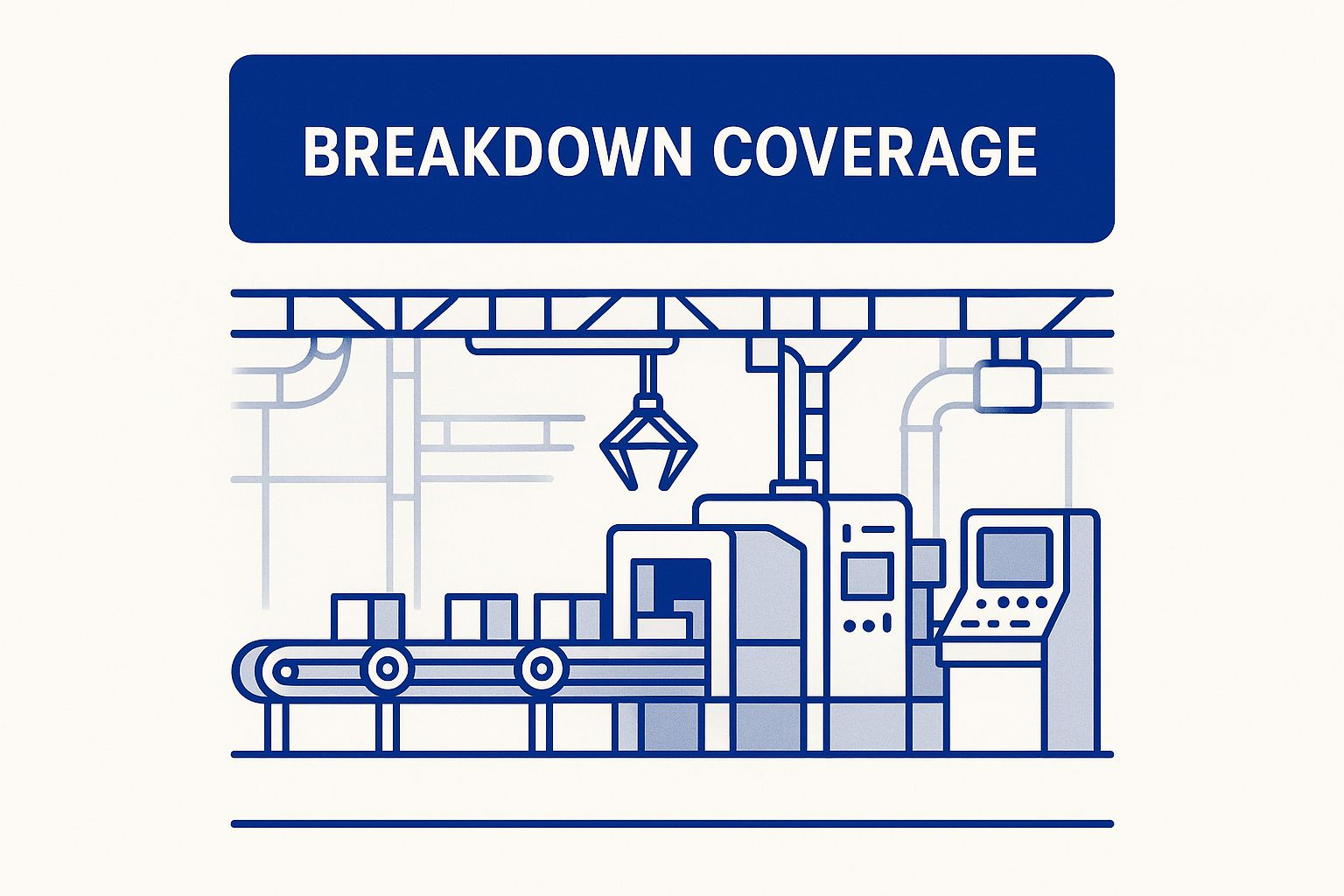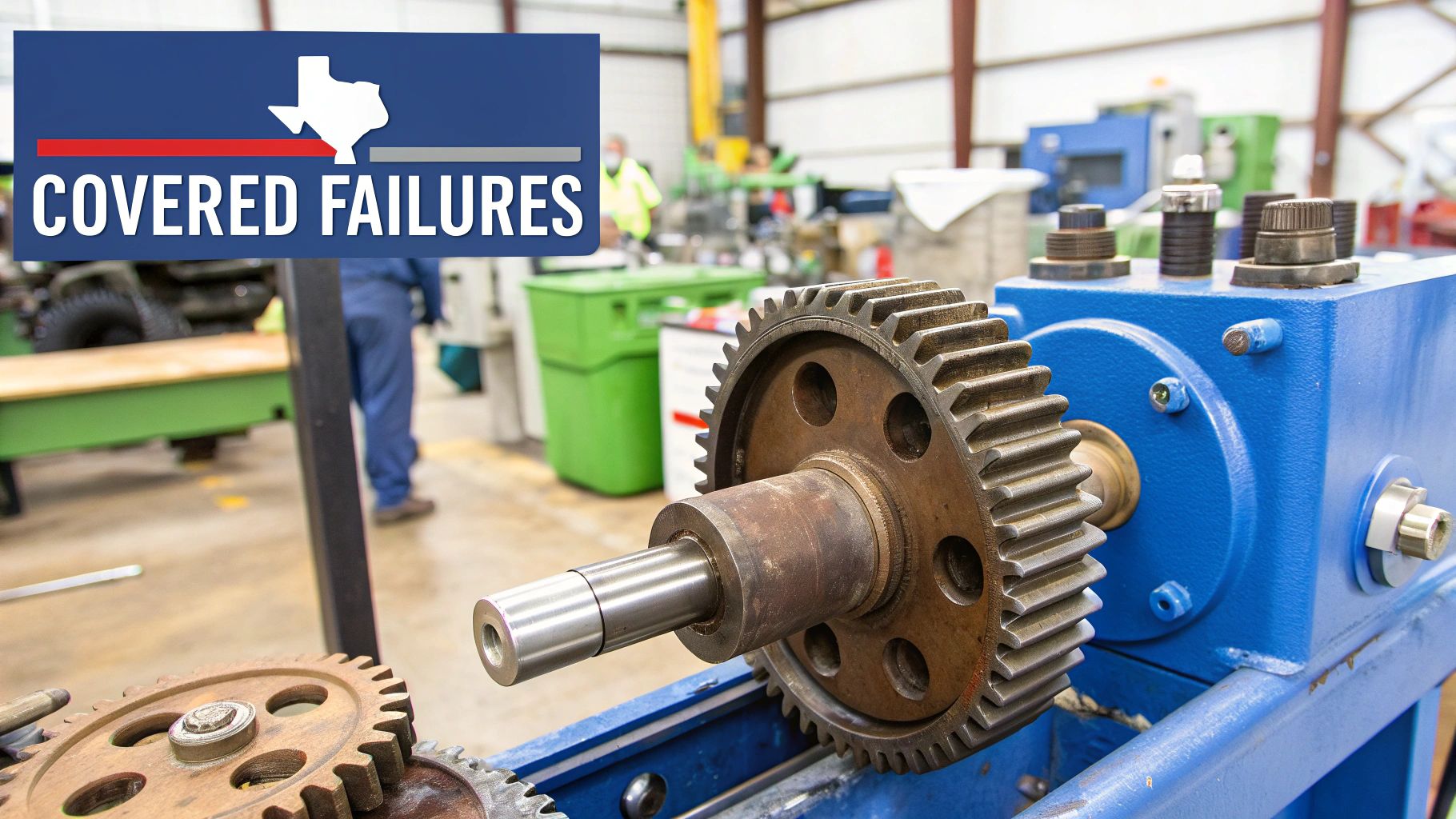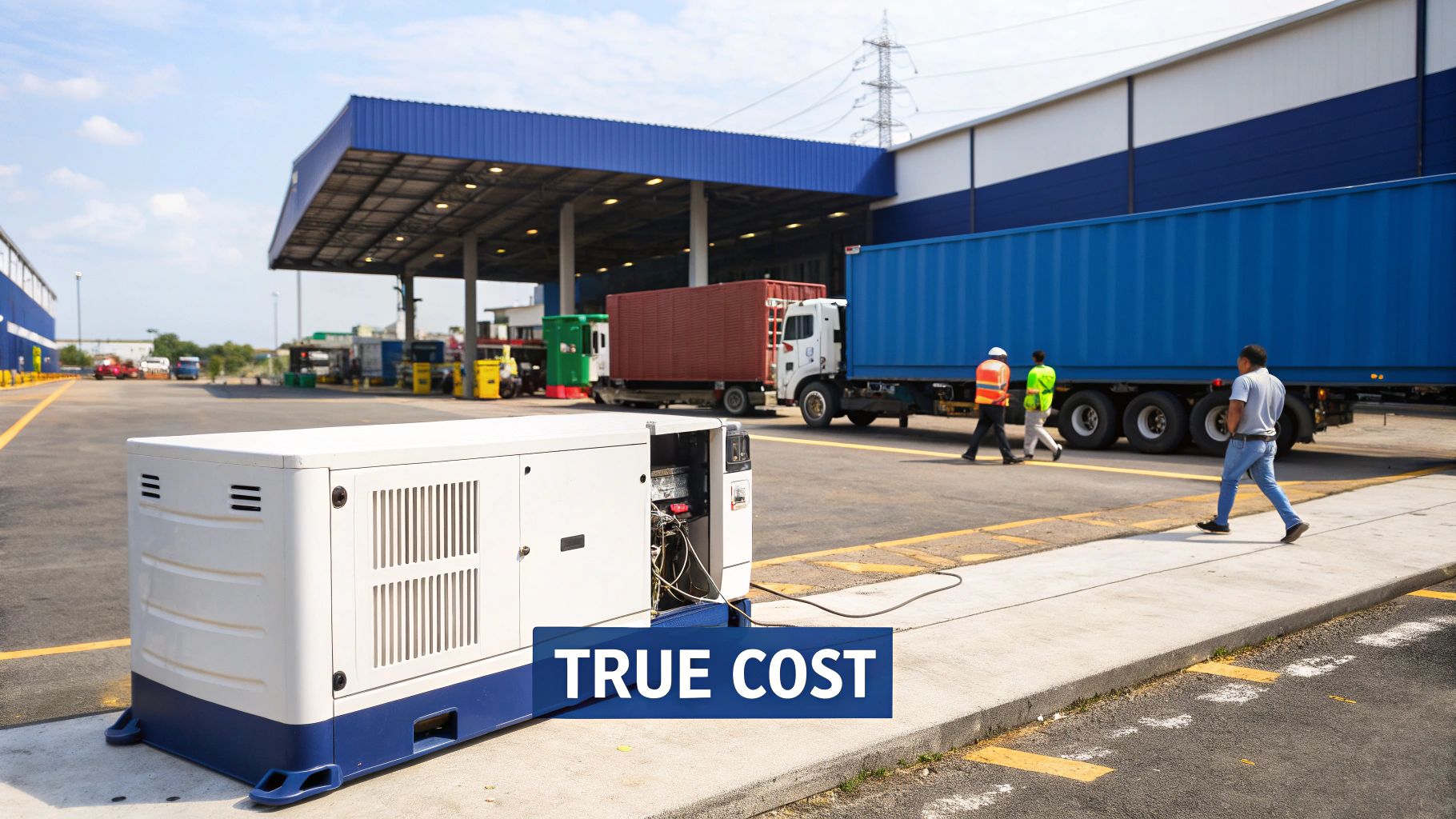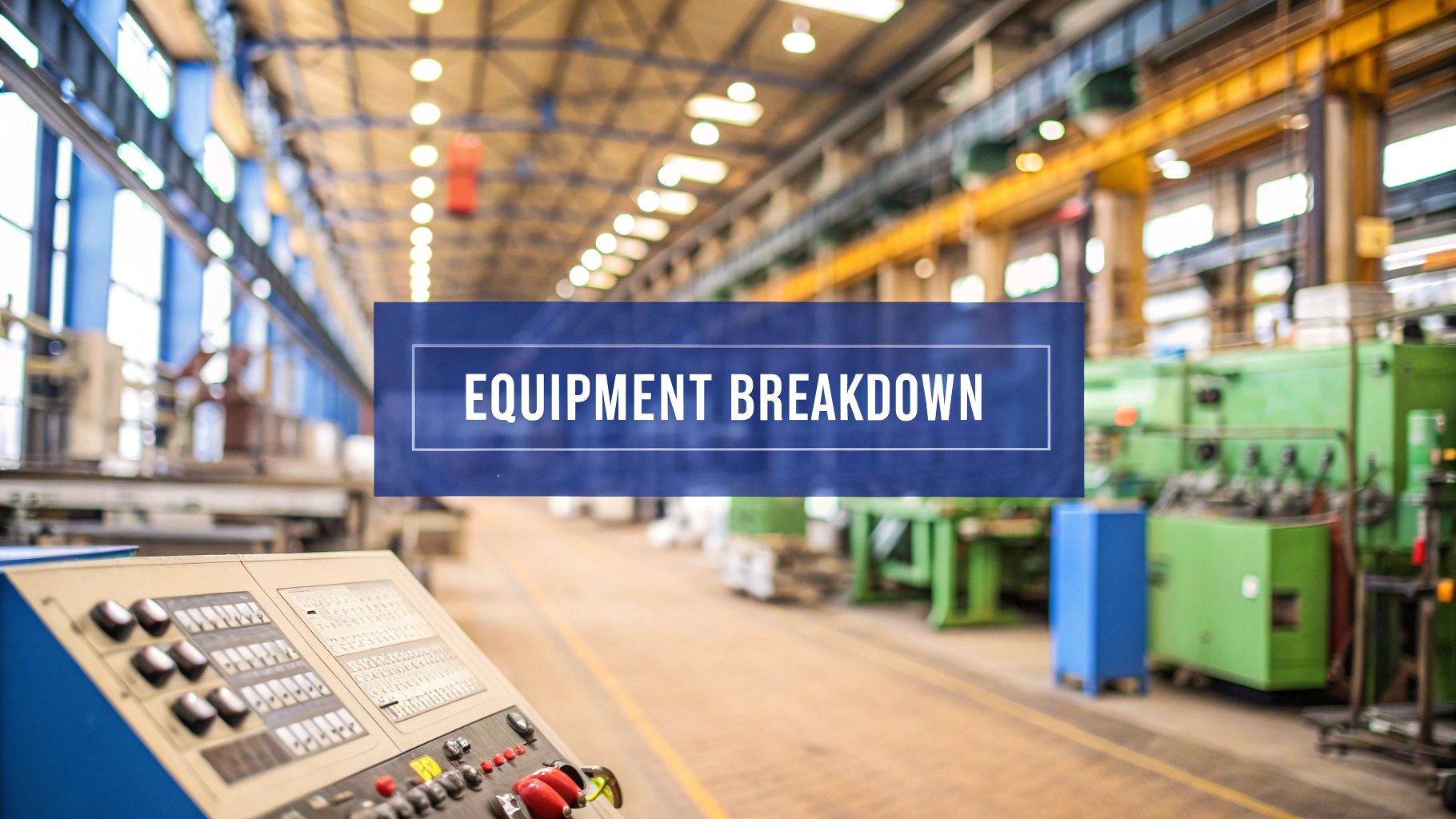Equipment breakdown coverage is a specific type of risk transfer mechanism designed to protect the internal components of machinery. It activates when a critical piece of equipment fails due to a sudden and accidental internal event. This is distinct from standard property insurance, which typically covers damage from external forces like storms or fires. Equipment breakdown coverage addresses failures originating within the machine itself, such as an electrical short that damages a control panel, a motor burnout, or the sudden failure of a pressure vessel.
The Critical Gap Addressed by Equipment Breakdown Coverage
For businesses in Texas's capital-intensive industries—such as Energy & Petrochemical, Manufacturing, Logistics, Agriculture, and Construction—machinery is the operational core. A single equipment failure can halt an entire production line or a major project, leading to significant financial consequences that extend far beyond the immediate repair costs.
This is precisely where equipment breakdown coverage becomes relevant. It is designed to cover a specific—and often overlooked—risk that standard commercial property policies typically exclude. While property insurance protects assets against external threats, breakdown coverage serves as a financial backstop for the internal mechanical and electrical failures that can disrupt operations.
The infographic below helps visualize the unique role this coverage plays in protecting a facility's essential operational systems.

As shown, the policy can directly shield the systems that generate revenue, from electrical infrastructure to core production machinery.
What It Protects
At its core, equipment breakdown coverage (historically called boiler and machinery insurance) is designed to absorb the financial shock of a sudden, accidental failure of essential equipment. It addresses internal issues like power surges, motor burnout, and even certain types of operator error, which are often outside the scope of a standard property policy.
Coverage typically includes not just the cost to repair or replace the damaged equipment, but also the potential ripple effects of the failure. This can encompass business interruption losses, the cost of renting temporary equipment, or expenses for expedited shipping to get parts on-site faster. Understanding these protections is a key component of a comprehensive risk management plan. Decision-makers aiming to build a more resilient operation can see how this fits into a larger strategy in our guide to operational risk management.
To clarify the distinction, let's compare it directly to a standard property policy.
Equipment Breakdown Coverage vs. Standard Property Insurance
This table breaks down the key differences, helping Texas business leaders understand the unique protections equipment breakdown coverage may offer.
| Coverage Aspect | Standard Property Insurance | Equipment Breakdown Coverage |
|---|---|---|
| Covered Perils | External events like fire, theft, windstorms, and vandalism. | Internal events like electrical arcing, mechanical failure, and pressure vessel explosion. |
| Focus | Protects the building and its contents from outside forces. | Protects the internal workings of specific machinery and equipment. |
| Typical Exclusions | Mechanical breakdown, electrical shorts, boiler explosion, power surges. | Wear and tear, corrosion, rust, and damage from external events (covered by property insurance). |
| Example Scenario | A hurricane damages a manufacturing facility and the machinery inside. | A power surge fries the control panel of a main production machine, halting operations. |
As the table shows, these two policy types are designed to be complementary, not overlapping. One protects from external events, while the other addresses internal failures that can disrupt a business.
Disclaimer: ClimateRiskNow does not sell insurance or financial products. The information provided in this article is for educational purposes only and should not be interpreted as financial advice or an insurance recommendation. The purpose of this content is to help business leaders assess, prepare for, and mitigate operational risks.
What Types of Equipment Failures Are Actually Covered?

To understand the practical application of equipment breakdown coverage, it is necessary to move past general definitions and examine specific failure scenarios. This coverage is designed to respond to distinct, internal failures that can halt operations, particularly in capital-intensive sectors across Texas.
The policy is intended for the sudden, accidental, and internal failure of essential machinery, not for equipment that deteriorates slowly. For example, it could apply to a power surge that damages a critical CNC machine in a Dallas-area manufacturing plant or a seized compressor that stops work at a Permian Basin energy facility. These are abrupt, unexpected events originating from within the equipment. Let's examine the core types of failures it is designed to protect against.
Mechanical Breakdowns
This is the most direct category, referring to the sudden physical failure of machinery components. These are not problems that develop over months; they are abrupt events that cause an immediate cessation of function.
For a Houston-based construction firm, this could be a crane's hoisting mechanism failing due to a seized bearing. For an agricultural operation in the Rio Grande Valley, it might be the catastrophic failure of a gearbox on key processing equipment during harvest season.
Common examples include:
- Seized Motors: A motor on a conveyor belt locks up, stopping an entire production line.
- Bearing Failures: Critical bearings in a turbine or generator fracture, causing an immediate shutdown and significant internal damage.
- Broken Shafts or Gears: A key component inside a machine snaps under normal operational stress, rendering it inoperable.
Electrical and Electronic Failures
Modern industrial equipment is integrated with complex electronics. When these systems fail, it is often instantaneous and can be triggered by events like an internal short or a disturbance from the power grid. The costs can be substantial; downtime for a single production line can cost some manufacturing firms over $50,000 per hour.
A logistics hub near the Port of Houston could experience an electrical arc that destroys the main control panel for its automated sorting system. A petrochemical plant might face a short circuit that disables a critical safety monitor, forcing an emergency shutdown. Understanding the diagnostic procedures for such failures is important, which is why we have detailed related measures in our guide on transformer oil tests.
For decision-makers, the key insight is that an electrical failure is rarely limited to one component. The primary risk is the cascade effect on interconnected systems. The resulting downtime often dwarfs the initial repair cost.
Pressure and Vacuum System Failures
For many Texas industries, particularly in energy and manufacturing, equipment operating under extreme pressure or vacuum is essential. A sudden failure here represents not just an operational disruption but also a significant safety hazard.
This coverage addresses events like the sudden cracking of a steam boiler, a compressed air tank rupture, or the failure of another pressurized vessel. For instance, a burst steam pipe in a manufacturing plant can cause widespread damage and halt production for days or weeks. These are catastrophic failures driven by internal forces, not slow leaks.
HVAC and Refrigeration System Breakdowns
In Texas, reliable climate control is an operational necessity. For businesses in agriculture, food processing, or logistics, a refrigeration failure can result in a total loss of perishable inventory.
Similarly, if a commercial HVAC system breaks down in a large factory during an extreme heat event, working conditions can become unsafe, potentially forcing a shutdown and violating OSHA regulations. Equipment breakdown coverage can address these internal failures, such as a compressor burnout in a large-scale refrigeration unit or the mechanical failure of a central AC chiller.
Calculating the True Cost of an Equipment Failure

When a critical piece of machinery fails, the initial repair bill is merely the visible portion of the total financial impact. For Texas businesses in sectors like manufacturing, petrochemicals, or logistics, the true cost emerges from the ensuing operational disruption.
To accurately assess risk, executives must look beyond the immediate fix and calculate the total cost of failure. This total cost is composed of two categories: direct costs and indirect costs. While direct costs are straightforward, indirect costs are often more substantial and can significantly impact the bottom line.
The Clear and Present Danger of Direct Costs
Direct costs are the immediate, out-of-pocket expenses required to restore a broken piece of equipment to operational status. These figures appear on invoices and are easily quantifiable.
- Repair Labor: Costs for specialized technicians, often at premium rates for emergency or after-hours service.
- Replacement Parts: The expense of new components, from simple bearings to complex circuit boards.
- Full Equipment Replacement: In cases of catastrophic failure, replacing an entire machine represents a significant, often unplanned, capital expenditure.
- Expedited Shipping: When each hour of downtime has a high monetary cost, paying a premium for overnight delivery of a critical part is a necessary expense.
These costs are simple to track but can escalate quickly, particularly for specialized or older machinery where parts are not readily available.
Uncovering the Hidden and Higher Indirect Costs
Indirect costs represent the true financial threat. These are the consequential losses that ripple outward from the initial breakdown. They are more difficult to quantify but almost always cause the most significant economic damage.
The true financial impact of an equipment failure is rarely the repair bill. It's the lost production, the missed deadlines, and the damage to customer relationships that cause the most lasting harm. A comprehensive business impact analysis is crucial for quantifying these hidden risks.
Consider this scenario: a critical generator fails at a large logistics hub near Dallas during a heatwave that is straining the electrical grid. The direct cost to repair it might be $30,000. However, the indirect costs quickly eclipse that amount:
- Lost Income: With sorting and loading systems down, the hub cannot process shipments. If the outage lasts 12 hours and the facility typically generates $25,000 per hour in revenue, that represents a $300,000 revenue loss.
- Temporary Equipment Rental: To mitigate further losses, the company rents several large mobile generators at an emergency rate of $5,000 per day.
- Spoiled Inventory: If the failure also disabled a refrigerated section, thousands of dollars in perishable goods could be lost.
- Reputational Damage: Failure to meet delivery commitments erodes client trust. A single significant failure can lead key clients to seek more reliable partners, impacting long-term revenue.
This heavy reliance on complex machinery is a primary driver of the growing market for managing this risk. The equipment breakdown insurance market was valued at approximately USD 7.35 billion in 2024 and is projected to reach USD 12.59 billion by 2031. More details on this trend can be found at Market Statsville. By understanding both direct and indirect costs, decision-makers can develop a far more accurate picture of their financial exposure. A crucial first step is to conduct a thorough assessment, which can be initiated using our business impact analysis template.
What Isn't Covered: Common Exclusions and Policy Gaps
Understanding what equipment breakdown coverage protects is only one part of the analysis. To build a resilient operational strategy, Texas business leaders must also have a clear understanding of what is not covered. Recognizing these limitations is key to avoiding unforeseen and costly gaps in a company's financial safety net.
This type of coverage is specifically for sudden and accidental internal failures. It is not intended for issues that develop slowly over time. This distinction is critical. For example, if an engine suddenly seizes, that is an abrupt, unexpected event. If it slowly loses power over thousands of hours of use, that is considered predictable wear. Equipment breakdown coverage is for the former, not the latter.
Gradual Deterioration Is Not Covered
A core principle of this insurance is the exclusion of issues stemming from normal aging and use. These policies are not maintenance contracts or replacement funds for old machinery. They are designed to respond to unexpected failures.
Be aware of several specific exclusions that fall under this category:
- Normal Wear and Tear: The expected decline in an asset's condition from regular operation. Parts that wear out on a predictable schedule are a maintenance expense, not an insurable loss.
- Rust and Corrosion: Damage that accumulates slowly from exposure to moisture or chemicals is typically excluded. This is a critical distinction for Texas businesses, particularly those operating in humid Gulf Coast environments or chemical processing facilities.
- Erosion and Abrasion: The gradual wearing away of material from friction or flow is considered a maintenance issue, not an insurable breakdown.
These exclusions underscore the importance of a robust preventive maintenance program. Proper upkeep not only extends the life of equipment but also helps prevent failures that insurance will not cover.
External Events and Warranties
Another major area of exclusion involves damage caused by events outside the equipment itself. Equipment breakdown coverage is designed to work in conjunction with other policies, not to duplicate them. If another policy type covers the peril, it will almost certainly be excluded here.
A common point of confusion is the line between equipment breakdown coverage and standard commercial property insurance. The rule is simple: if the cause of the failure is internal, it may be a breakdown claim. If the cause is external, it's a property claim.
This means damages from events like fires, floods, windstorms, or theft are not covered under an equipment breakdown policy. Those risks fall under the purview of a standard commercial property policy.
Similarly, if a new piece of machinery fails and the issue is covered by the manufacturer's warranty, the breakdown policy will not apply. The manufacturer, not the insurer, is responsible for rectifying the defect. By understanding these boundaries, executives can conduct a more accurate risk assessment and ensure their various policies form a cohesive, gap-free financial safety net for the entire operation.
How Technology Is Changing Your Equipment Risk Profile
https://www.youtube.com/embed/GH9aVpRG9K4
The machinery powering Texas industries today is fundamentally different from the equipment of a previous generation. Assets are no longer merely collections of gears and motors; they are complex, interconnected systems integrated with sophisticated electronics, IoT sensors, and advanced control panels. This technological leap has created significant gains in efficiency but has also fundamentally altered the equipment risk profile for businesses.
Unlike purely mechanical assets, today’s smart equipment is vulnerable to a new class of internal failures. Power surges, microchip malfunctions, software glitches, and electronic arcing can all trigger a sudden, catastrophic breakdown. These are precisely the kinds of internal electrical and electronic failures that equipment breakdown coverage is designed to address. This shift means a failure is rarely a simple mechanical issue anymore. Instead, businesses often face intricate problems that demand specialized diagnostic tools and highly skilled technicians, leading to longer downtime and more expensive repairs.
The Rise of Interconnected Vulnerabilities
The integration of technology creates a network effect within a facility. A single electronic failure can now cascade through interconnected systems, causing widespread disruption that extends far beyond the initial failed component. This makes understanding operational vulnerabilities more critical than ever.
Consider these modern risk scenarios:
- A Programmable Logic Controller (PLC) in a manufacturing plant experiences an internal short, bringing an entire automated assembly line to a halt.
- An IoT sensor network managing irrigation on a large-scale agricultural operation malfunctions due to an electrical fault, leading to crop damage and significant financial loss.
- The electronic control unit (ECU) in a critical piece of construction machinery fails, rendering a multi-million dollar asset useless until a replacement can be procured and programmed.
In each case, the failure is internal, electronic, and sudden—falling outside the scope of standard property insurance but within the intended scope of equipment breakdown coverage.
As equipment becomes more advanced, the nature of its failure shifts from mechanical wear to electronic malfunction. A forward-thinking risk management plan must account for this reality, recognizing that the most significant threats now often come from within the machine's own circuitry.
Data-Driven Risk and Evolving Protection
This technological evolution is also changing how risk itself is managed. The integration of technologies like IoT and predictive analytics allows insurers to offer more customized, data-driven policies that refine risk assessment and pricing. Key sectors driving this demand include manufacturing as the largest end-user, alongside logistics, energy, and construction. You can read more about the rising costs and technological shifts in the insurance industry at Travelers.com.
This growing reliance on data mirrors the need for businesses to adopt more analytical approaches to their own risk management. By understanding the specific electronic vulnerabilities of key assets, executives can engage in more informed discussions about operational resilience. You can explore this topic further by learning about the role of data analytics for insurance. For Texas business leaders, the takeaway is clear: as your equipment gets smarter, the associated risks become more complex. Specialized financial protection is no longer an ancillary consideration but a core component of a modern, resilient operational strategy.
Building a Resilient Operational Risk Strategy
Understanding the specifics of equipment breakdown coverage is an important step, but this knowledge is most powerful when integrated into a proactive, company-wide operational risk strategy. For Texas businesses in demanding sectors like manufacturing, energy, and logistics, a single policy is not a comprehensive solution; it is one vital layer in a multi-faceted defense against disruption.
True operational resilience is not just about transferring risk—it’s about actively reducing it. The primary goal is to build a framework for anticipating potential failures and mitigating their impact before they can become catastrophic events. This requires a systematic approach, combining financial protection with disciplined on-the-ground operational practices.
Creating a Multi-Layered Defense
A robust strategy begins with a thorough and objective assessment of operations. This involves going beyond a simple asset inventory to strategically evaluate the role each machine plays in revenue generation and the specific vulnerabilities it introduces.
To build this defense, business leaders should focus on several key pillars:
- Comprehensive Equipment Audits: Identify which machines are critical to operations and quantify the financial impact of their failure.
- Preventive Maintenance Schedules: A well-documented and strictly followed maintenance program is the first line of defense. It helps prevent failures resulting from predictable wear and tear, which insurance typically does not cover.
- Rigorous Operator Training: A significant number of equipment failures can be traced to human error. Continuous investment in training ensures machinery is operated safely and correctly, reducing the risk of accidental damage.
By integrating these proactive measures, a company can create a system that is inherently more durable. This approach is the foundation of a stronger operational core, which is explored further in our detailed business resilience framework.
An effective risk strategy treats insurance as a backstop, not a primary solution. The most resilient companies focus first on preventing failures and minimizing downtime through operational excellence, using coverage to handle the unpredictable events that still slip through.
When a major loss does occur, the claims process can be complex. For comprehensive risk management, particularly when facing significant losses, businesses may find value in leveraging a public adjuster to manage commercial claims to ensure they have a dedicated advocate. This guide is intended to provide the knowledge needed for more strategic conversations about protecting a company’s operational core.
Here is a quick checklist to help begin reinforcing your defenses.
Actionable Risk Mitigation Checklist
This checklist provides a practical starting point for business leaders to assess and improve their equipment-related risk management practices.
| Action Item | Purpose | Internal Link |
|---|---|---|
| Identify Critical Assets | Pinpoint equipment whose failure would cause immediate and significant operational or financial disruption. | business resilience framework |
| Quantify Financial Impact | Calculate the daily cost of downtime for each critical asset, including lost revenue and fixed expenses. | business resilience framework |
| Review Maintenance Logs | Audit maintenance records for the past 12 months to identify recurring issues or overdue service. | business resilience framework |
| Assess Operator Training | Verify that all equipment operators have up-to-date training certifications and a clear understanding of protocols. | business resilience framework |
| Simulate a Failure Scenario | Conduct a tabletop exercise to walk through your response plan for a critical equipment failure. | business resilience framework |
By systematically working through these points, a business can transition from a reactive posture to a proactive one, building an operation that is truly prepared for unexpected events.
Disclaimer: ClimateRiskNow does not sell insurance or financial products. The information provided in this article is for educational purposes only and should not be interpreted as financial advice or an insurance recommendation. The purpose of this content is to help business leaders assess, prepare for, and mitigate operational risks.**
Common Questions About Equipment Breakdown Coverage
As with any insurance policy, specific questions often arise. The following are some of the most common inquiries from Texas business leaders when determining how this coverage fits into their risk management strategy.
We Already Have a Great Maintenance Program. Do We Still Need This?
Yes, this is advisable. A maintenance program is the first line of defense, but it is not a complete shield. Maintenance addresses predictable wear and tear and gradual deterioration. This coverage is not designed for those issues.
Equipment breakdown coverage is for sudden, unexpected events that a maintenance schedule cannot predict, such as a power surge from the grid that damages a control panel, a hidden defect causing a catastrophic mechanical failure, or a boiler system that suddenly over-pressurizes. The two work in tandem: maintenance reduces the frequency of failures, while breakdown coverage provides a financial backstop for the accidental events that can still occur.
What About Equipment We Lease or Rent?
This is a critical detail determined by the specifics of your policy and lease agreement. Most standard equipment breakdown policies are written to cover only equipment owned by the policyholder.
However, a lease or rental contract likely holds you responsible for any damage that occurs while the equipment is in your possession. If so, a specific endorsement may be needed to extend coverage to that rented machinery. It is essential to review both documents concurrently to ensure there are no uninsured gaps in your risk management plan.
How Is This Different from a Manufacturer's Warranty?
These are designed not to overlap. A manufacturer’s warranty is a guarantee against defects in parts or workmanship. If a new compressor fails due to a factory defect, the warranty would address it.
Breakdown coverage typically applies in two main scenarios:
- The failure is caused by an event not covered by the warranty, such as an employee error or an external power surge.
- The equipment fails for a covered reason after the warranty has expired.
A warranty protects against a defective product; breakdown coverage protects against operational accidents.
Key Takeaway: Think of a warranty as protection against product defects, while equipment breakdown coverage is protection against operational accidents. They are complementary layers of risk management, not overlapping ones.
Does This Cover Lost Data or Corrupted Software?
Typically, no. Standard equipment breakdown policies are focused on the physical hardware—the "covered equipment." They are designed to pay for the repair or replacement of the tangible machine itself.
The financial consequences of lost data, corrupted software, or the cost of reprogramming are almost always excluded. For instance, if a power surge destroys a server, this policy would cover replacing the server hardware. However, the cost to restore data from backups or purchase new software licenses would likely need to be covered by a separate cyber liability policy. For any modern Texas business, this is a crucial distinction, as the data is often more valuable than the hardware on which it is stored.
ClimateRiskNow provides location-specific risk intelligence to help Texas businesses quantify their exposure to severe weather and other operational threats. Our assessments empower you to make data-driven decisions that enhance resilience and protect your bottom line. To see how our insights can strengthen your risk management strategy, request a demo.

